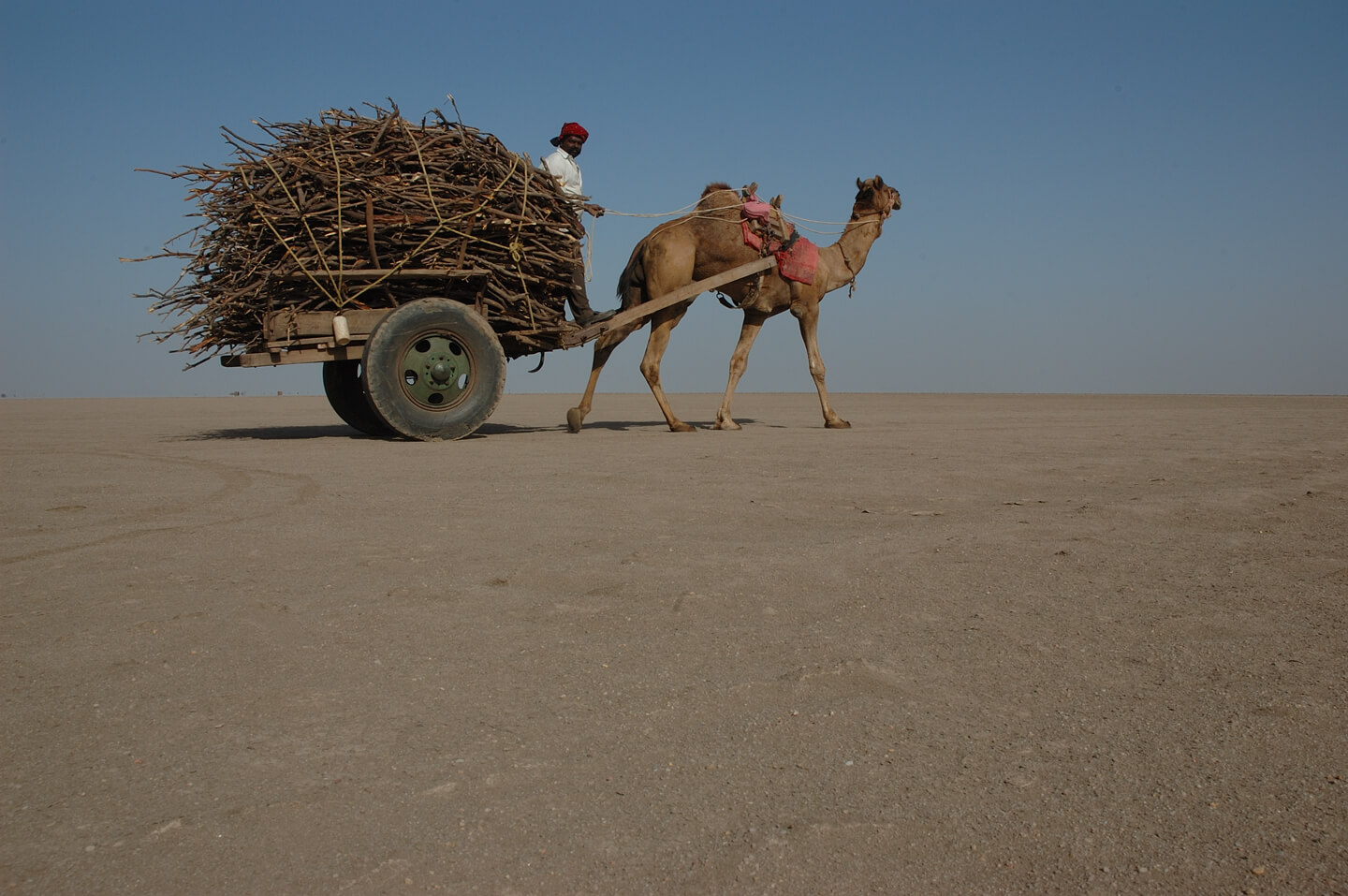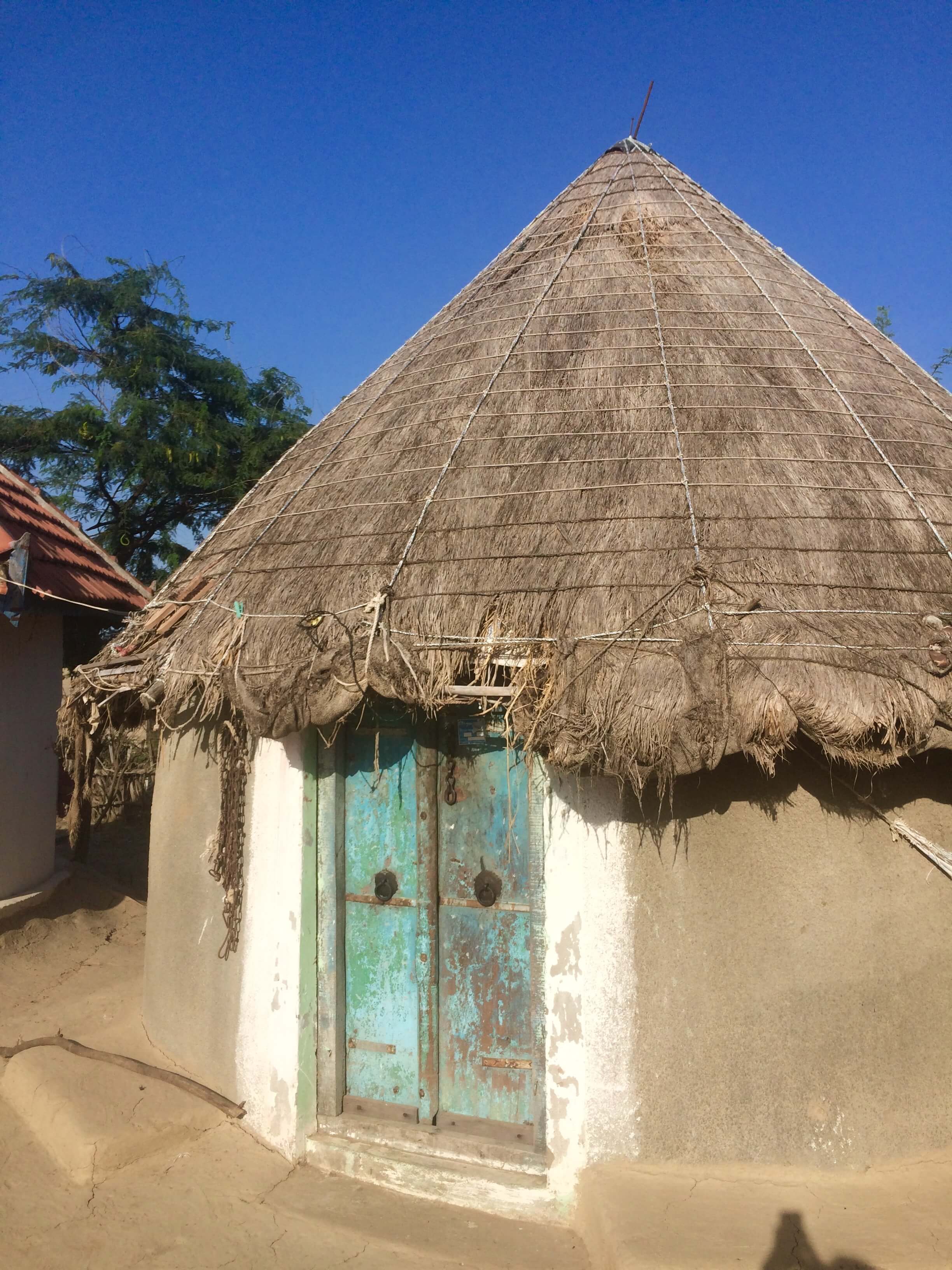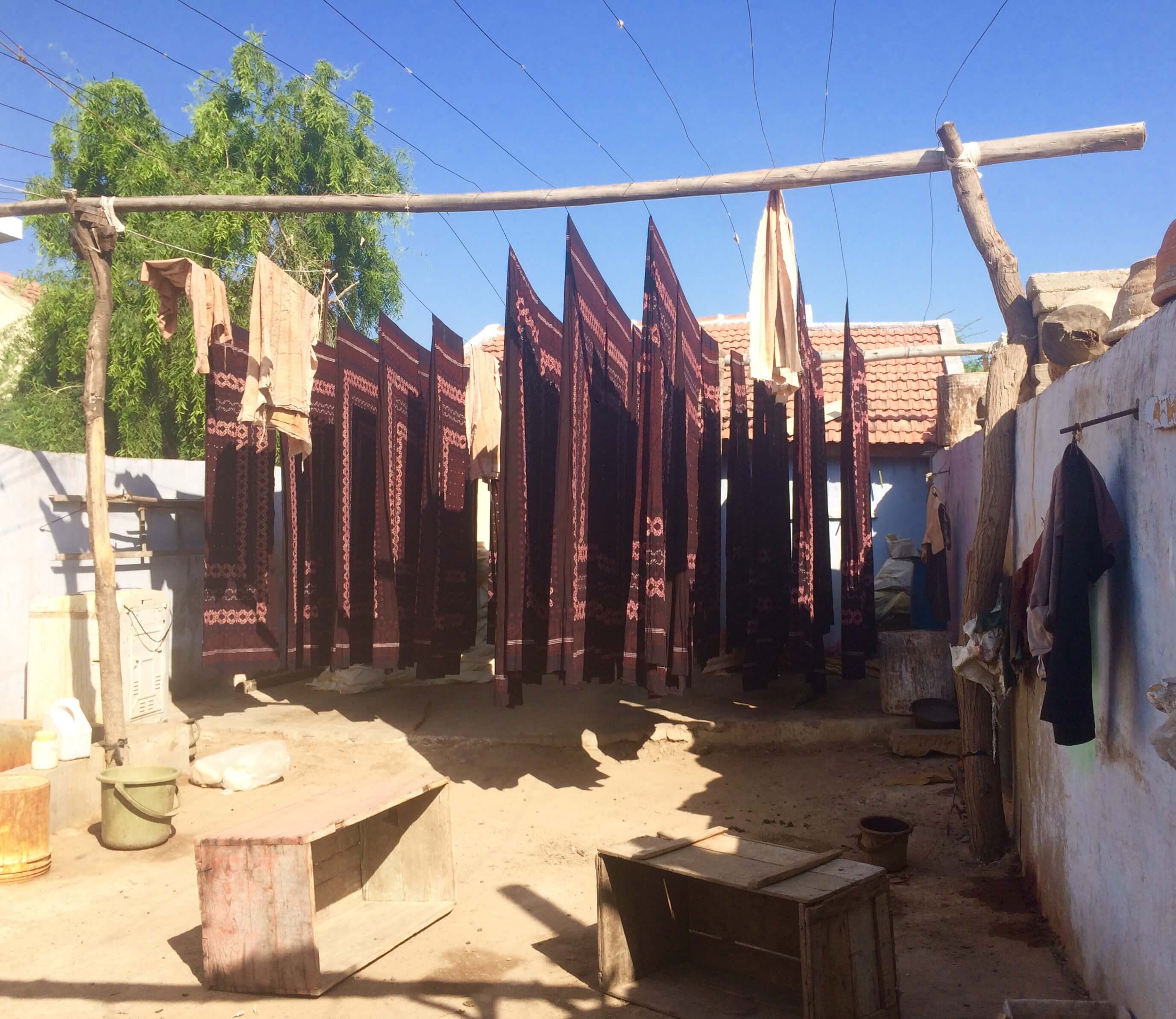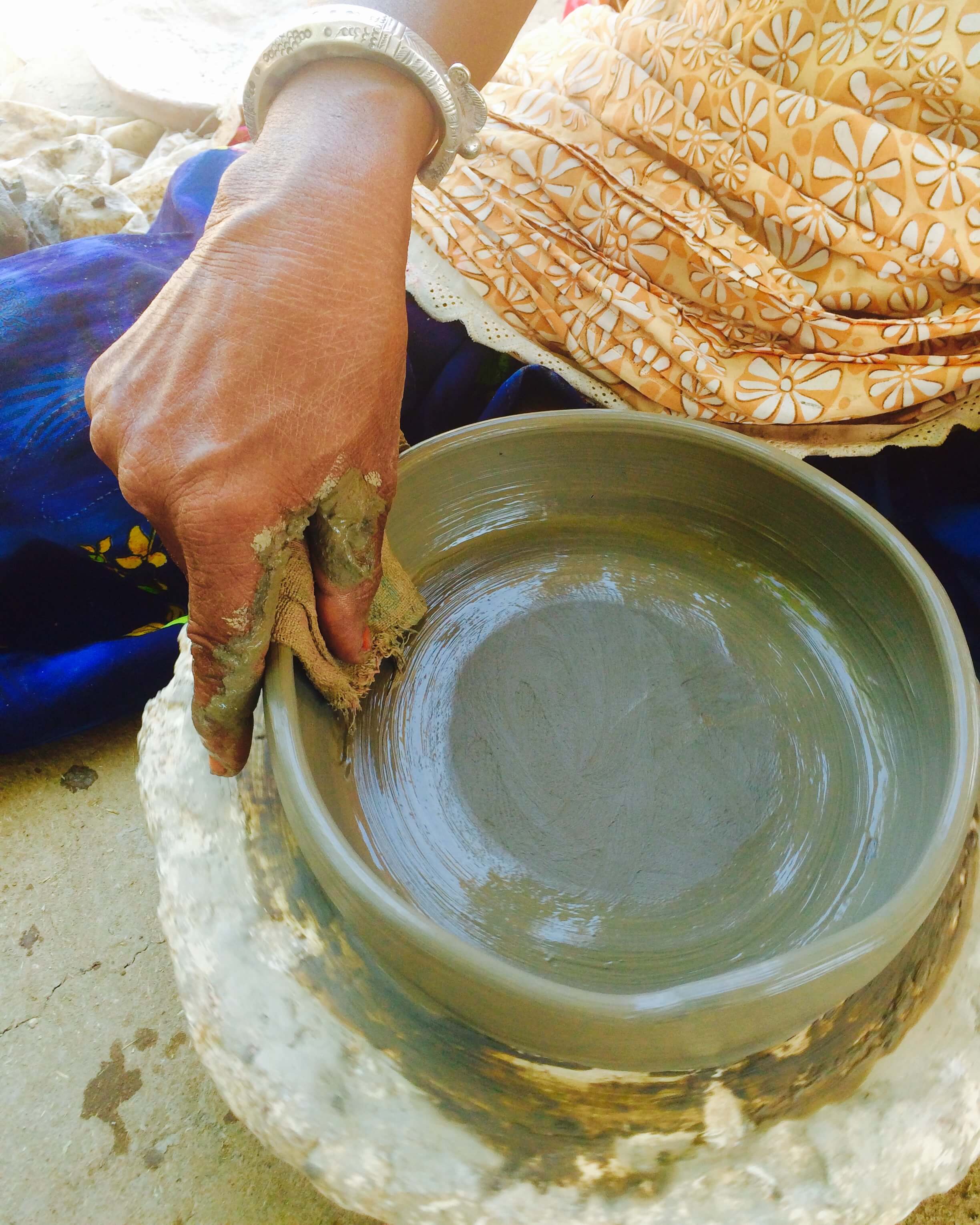Doubts about my sanity and impending travel plan were topmost on my mind as I gulped down the last of my chai. My mobile phone was ringing and Kuldip’s name flashed on the screen. For a brief moment I wondered if what I was doing was hare-brained.

Large tracts of land are completely flat and barren, devoid of a single blade of grass. Photo Credit: Wikimedia Commons / Vinod Panicker
I didn’t know Kuldip, but I’d hired him as a guide to take me around Kutch, on the basis of the review of a solo woman traveller on TripAdvisor. I’d landed in Bhuj on the back of 15-year-old memories of beautiful pieces of hand-painted pottery. My sister had done an internship with a potter’s family in Khavda, a village in Kutch, while she was a student at the National Institute of Design in Ahmedabad a decade-and-a-half ago. She’d returned with incredible pottery and stories of the place and its people. Kutch had been on my radar since then.
With an itch to travel on my own, I’d booked myself a ticket to Bhuj on a whim, and contacted Kuldip. And in no time, there he was in front of me. After a quick introduction, I threw my bag into the boot of his white Maruti 800 and settled into the rear seat. I tried to appear calm. Inside, I was a cocktail of nervousness and excitement. Saying a silent prayer for my safety, I tried to push away niggling doubts and focus on the next two days, during which I planned on driving to craft villages scattered across Kutch. Meeting the different communities, including the family my sister had stayed with was high on my agenda. I confessed to Kuldip that I didn’t have their contact details. All I had was the name of the village and a crystal-clear image of the stunning pottery they produced.
As we drove down NH341, traces of Bhuj and city life faded away. Anxious as I was, I lost no time in establishing that I was married and had a three-year-old daughter. Kuldip and I were two strangers in a small car, heading out towards the vast, open, and barren landscape of Kutch—I was seeking an adventure, and he was facilitating it by doing his job.
Located on the westernmost extremity of India, Kutch is an expansive salt marsh. In the dry season, the land breaks into honeycomb-like cracks, and in the monsoon, large tracts lie submerged under water. The pastoral and nomadic communities who inhabit the region are a sturdy lot and have adapted to living in these tough conditions.
The further we drove from Bhuj, the more familiar Kuldip seemed with the land and its people. A casual greeting, a smile, a nod, every-one was duly acknowledged, and some even welcomed into the back seat if they needed a ride.
Nirona, 40 kilometres northwest of Bhuj, was our first stop. Some of the region’s finest crafts come from this nondescript village. It shot into the limelight when Prime Minister Modi gifted President Obama a painting from this village on his maiden visit to the White House. Traditionally used to decorate bridal wear, Rogan painting is done using pigments made from the oil of castor seeds, a crop that’s cultivated in the area. Until a few years ago, several villages across Kutch practised Rogan art, but today only the Khatri household in Nirona keeps this art form alive. Sitting on the floor of the Khatri household, we watched Sumarbhai Khatri dip a six-inch-long stick into some paint and draw out a fine thread on a piece of cloth he held in one hand. Watching his nimble fingers form curvy lines, twisting the sticky paint around, was almost therapeutic. I felt my nervousness and stress abate. Such is the finesse of the end product that Rogan-painted cloth often looks like it is printed rather than hand-painted.

Castor oil is boiled and the residue once it cools is mixed with pigments to get different colours.
After the demonstration we sipped sweet, milky chai from saucers. Our conversation was gently interrupted by a melodious tinkling coming from a large herd of cattle making its way out of the village. To keep track of their massive droves, local herders tie ghantadis or copper bells around the necks of their cattle. Next, we entered the home of Hussein Siddiq Luhar who was surrounded by tools and busy on the floor of his small workshop. He was beating scrap metal sheets into bell shapes, joining them together using a locking system without any kind of welding. When dipped in a mixture of mud and powdered copper and baked in a kiln, the bells get a gleaming copper sheen.
Back on the highway, with me now comfortably settled in the front beside Kuldip, our conversations became more relaxed. The day wore on and a hot, dry breeze blew through the open windows. The heat singed our skin. Mirages glistened on the road ahead. For company, we had hoopoes, drongos, and kingfishers, perched on the electricity poles running alongside roads.

Traditional mud houses known as bhungas are found across Kutch. Made using all natural materials, they are designed to be earthquake resistant.
I was glad to get off the road and into the cool of a bhunga or traditional mud hut of the Mahefeel e Rann Resort at Hodka. After a lunch of Kutchi staples of rotla, gur, a side of kathor, dal, and cold chaas, and then a short nap, we drove to the craft village of Hodka. Kuldip warned me not to fall for the tourist trap in which little girls dressed like princesses lure visitors to buy souvenirs. My ears heard him, but not my mind. In no time I was sitting in a bhunga with Kavita, her mother and siblings, looking at exquisite embroidered creations. I did yield to their persistence and left with hair accessories for my daughter.
That night, lying on a charpoy under a canopy of stars, whatever traces of self-doubt I had about my trip and my guide melted away. Kuldip on his charpoy was silent, lost in his thoughts. I felt calm, and tried to plot my life, feeling like a mere speck in the larger canvas of the universe.
The next thing I knew it was morning, and I could hear the faint sound of ghantadis tinkling in the distance. Our journey continued north towards Khavda, the village that had brought me to Kutch. The flat sun-baked land stretched out on either side of us, but there was a small dot on the horizon, gradually growing in size. As the distance between us reduced we realised it was a tall, hardy woman in her fifties. Sari-clad Alamelu was carrying all her worldly possessions with her, including a broom. The back seat of our car was empty and hers for the taking.
Since I spoke Tamil and could understand her, she shared her story with us. She had left home 30 years ago because of a fight with her family, and since then had traversed hundreds of kilometres on foot. She said she was hoping to journey home to Tamil Nadu, but didn’t seem to understand that she was walking towards the India-Pakistan border. It seemed strange to us that she had been getting around without a common language or money, and we felt we ought to help her.
At Khavda, we dropped her at a bus stop on the outskirts of town with the promise that we would pick her up later in the day, when we continued our drive to Bhuj. It was midday and the streets wore a deserted look except for a few sauntering cows.
Inside the flat-roofed houses we visited Ajrakh printers who were busy dying and printing fabric. It takes an elaborate multi-step process to produce an authentic piece of Ajrakh fabric. Hand printed on both sides, a true test of its quality is if the colour doesn’t run when washed.

Ajrakh fabric put out to dry in the sun.
At the other end of Khavda was the kumbhar (potter) family I was looking for. When Kuldip introduced
me to the matriarch, Saraben, I reminded her about my sister. She flashed a grin and drew me into an embrace. That warm hug made the effort I had put into finding her worthwhile. Her flock of grandchildren surrounded me, happy to have a visitor in their midst. Saraben chatted and continued to decorate a plate she was making with fine black-and-white lines and dots. Though the designs were simple, the end result was spectacular.

Saraben continued to work as we chatted.
A small adjoining room displayed the different products the family made. Saraben proudly showed me newspaper cuttings and photographs of the national awards they had won over the years. In turn, I showed her photos of my sister and her family, and Saraben fondly remarked that she looked just the same.
Satisfied with having met my sister’s host family, we set out to find Alamelu. As I had half expected, she was gone from the place she had promised to meet us. We asked around, but no one seemed to have seen her. We drove on further north to Kala Dungar, the highest point in Kutch, and from there to India Bridge, the last point near the border that civilians can access without a permit. The sole jawan at the checkpost there was happy to have company, even if for a short while. During off-season, which is the larger part of the year, hours pass without him seeing anyone, he said. Driving back towards Bhuj, we passed a group of men surrounding someone. On closer inspection we found it was Alamelu, who was being heckled because she spoke only Tamil. We quickly dispersed the small crowd and got her back in the car. As we drove on, I wondered: Would I have been so open to helping a stranger had I been in the city? I don’t think so. Out on the road, I felt my inhibitions had loosened.
Kuldip and I decided to take Alamelu to a local NGO in Bhuj and ask if they might help her find her way home. But they declined to help and so we decided to do something for her ourselves.
We took her to the railway station and finding no direct trains to the south, bought her a ticket to Mumbai hoping it would take her one step closer to Tamil Nadu. At the entrance to platform 1 of Bhuj Station we handed Alamelu her ticket. Kuldip and I were talking, and took our eyes off her for what must have been less than a minute. When we turned around, she was gone. Just like that, she had vanished without a trace.
Overwhelmed with the day’s events and the journey, Kuldip and I shared one last chai discussing what had just happened and saying our goodbyes. I was miles away from home and part of me expected the unexpected. But for Kuldip, who knew the land and its people like the back of his hand, this bizarre experience was disturbing. This was the end of our trip and now we would go back to our families. What about Alamelu, I wondered. Did she really want to go home? Did she really even want our help? What was it like to be on the road with no one to answer to, no home to go to, nothing to be responsible for, and no one to stay in touch with? Kuldip and I on the other hand were ending this road trip as friends, bound by a somewhat surreal experience that will always fill us with a sense of disquiet.
Make It Happen
Bhuj is the largest city in Gujarat’s Kutch district. It’s a good base from which to explore the craft villages
of Kutch.
Getting there
Air Bhuj has only one daily flight, coming in from Mumbai. Alternatively, fly into Ahmedabad and drive down from there to Bhuj. Taxis charge approximately `2,500 for a one-way trip from Ahmedabad (332 km/5.15 hr).
Rail Bhuj is connected to Mumbai by several trains, including the daily Kutch Express. BE Bhuj Express connects New Delhi to Bhuj and operates on Monday, Wednesday, Friday and Sunday.
Road From Mumbai take NH48, NE1, NH47, NH947 and NH27 to Bhuj-Bhachau Highway in Gujarat. Take the exit from NH41 to Bhuj (855 km/ 13.5 hr).
Getting around
It’s best to hire a car to explore the different artisan villages in Kutch as public transport is erratic and can be very crowded. Hire a guide to take you around. The writer travelled with Kuldip (kutchadventuresindia.com; fee Rs 5,000 per day, includes taxi and guide).
***
Published in the April issue of National Geographic Traveller India as Tales from the Kutch. Read it on natgeotraveller.in here.

22 Comments
Abhijit
May 2, 2017 at 6:53 amI feel so envious. You are a courageous person. It gives a sense of exhilaration standing on the sand marsh and see the sun go down on the horizon.
Chaitali
May 2, 2017 at 6:54 amThanks Abhijit! Your comment brought an instant smile to my face. The trip really was about challenging my boundaries as a traveler and person.
Prasad Np
May 2, 2017 at 7:43 amWhat a surprising contrast these colors are to the barren landscape. And what a wonderful use of Castor Oil
Chaitali
May 2, 2017 at 10:25 amSo true! It grows abundantly in the region.
Tales of Travelling Sisters
May 2, 2017 at 10:24 amBeautiful and very engrossing writeup Chaitali! Its so interesting to read what you did as a solo traveller, got to say it was courageous and brave:)
Chaitali
May 2, 2017 at 10:26 amThank you. It really was a special trip and I guess that comes across in my writing.
It really was a special trip and I guess that comes across in my writing.
Urvesh Bhatt
May 2, 2017 at 1:48 pmWow, I must say you had an amazing trip. Inspired!
Chaitali
May 2, 2017 at 3:50 pmThanks Urvesh! Happy to hear that!
Hiral Amodia
May 3, 2017 at 2:15 amAmazing trip and beautiful post
Chaitali
May 3, 2017 at 4:34 amThank you Hiral!
Tara Nair
May 3, 2017 at 5:39 amHi Chaitali! I loved this article, lady you’re gutsy. Only one suggestion though… if possible please make the resolution a bit lesser. Since it is taking a longer time to upload the images and few haven’t uploaded only. Rest all is smashing good!!
Chaitali
May 3, 2017 at 7:49 amHi Tara, I love your feedback!
Thanks for pointing out the technical glitch – shall get it sorted.
Shrinidhi Hande
May 7, 2017 at 2:35 amFabric part was interesting
Chaitali
May 8, 2017 at 5:31 amThe crafts really are the highlight of the region. Thanks Shrinidhi! Nice seeing you here on these pages.
Russell
May 31, 2017 at 12:42 pmI was waiting for this type of issue. Thank you very much for the place.
Gregg
May 31, 2017 at 5:49 pmHi , I do believe this is a superior site. I stumbled
upon it on Yahoo , I’ll come back once again.
Bridget
June 1, 2017 at 3:38 amSaved as a favorite, I really enjoy your site!
Margarito
June 3, 2017 at 4:41 amI love it when folks come together and share opinions, great
blog, keep it up.
Swati & Sam (The Tales of a Traveler)
July 31, 2017 at 3:16 pmKutch is fascinating … would love to visit someday for sure
Love your writeup !!!
Holley
August 18, 2017 at 7:07 pmHi there! This post could not be written any better!
Reading through this post reminds me of my previous
room mate! He consistently kept talking about this.
I ‘ll forward this article to him. Fairly sure he’ll have a great read.
Thank you for sharing!
Agness of aTukTuk
September 12, 2017 at 10:33 amWow! This place seems magical! I really enjoyed reading your blog post, keep it up, Chaitali!
Shashank Ranjan
November 19, 2017 at 1:25 pmI was searching for a good article related to this beautiful destination and suddenly found yours. You have visually scripted this article and given an edge to grab the attention of the readers. I would appreciate your storytelling skill. Thanks for this wonderful post. Keep travelling and keep writing!